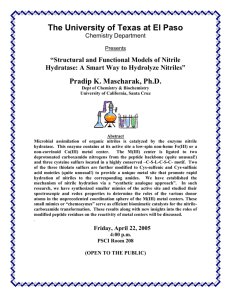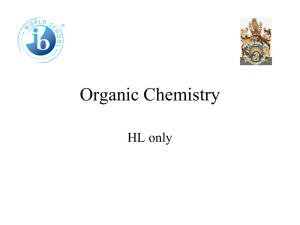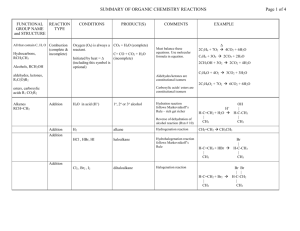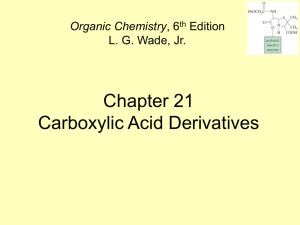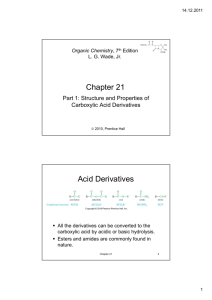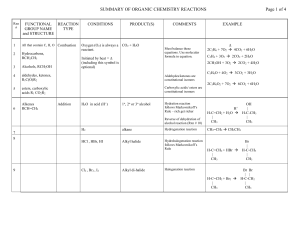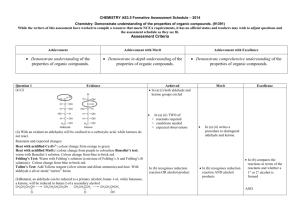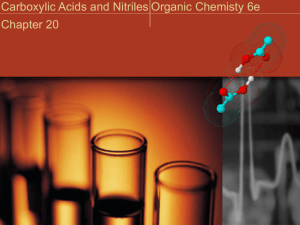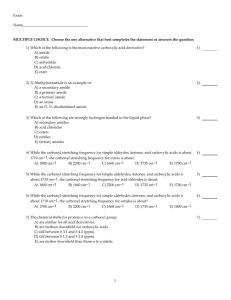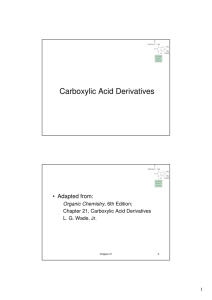Alkenes 6 - Chemistry
advertisement
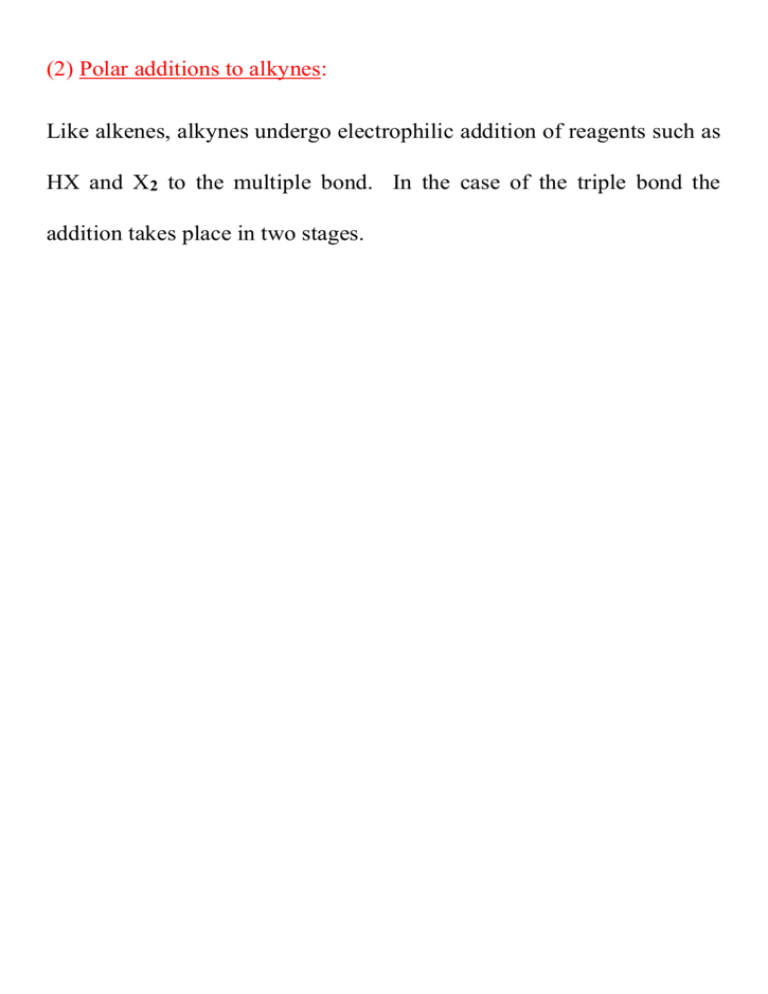
(2) Polar additions to alkynes: Like alkenes, alkynes undergo electrophilic addition of reagents such as HX and X2 to the multiple bond. In the case of the triple bond the addition takes place in two stages. Note that both HX additions follow the Markovnikov rule: + C C2 H5 H C X H C2H5 C + H C H sp : : Vinyl carbocation sp-hybridised and less stable than sp2 -hybridised alkyl carbocations. - :X: C C2H5 + + H C C : : H H X - C H C2 H5 - : H C :X H C2H5 H X H C C 2H 5 C H H : : :X: : X+ C C2 H5 X X H + C H C H H Although inductively electronwithdrawing the halogen atom can stabilise the adjacent carbocation by resonance. Terminal alkynes also undergo Markovnikov hydration in the presence of a mercury(II) salt as catalyst - but the final product is not an alcohol: R C CH H2 O Hg +2 HO H C R C H Tautomerisation O C R Enol CH3 Methyl ketone Internal alkynes are hydrated under acidic conditions without the need for a catalyst and give mixtures of products: CH3 C C H3O C2 H5 H C + C + C2 H5 + CH3 C + H C CH3 C2H5 H2O - H+ H OH C H2 O - H+ HO H C C CH3 C2H5 H H C CH3 O CH3 C2 H5 O H C H C2 H5 C C C2H5 C CH3 (3) Reductions of alkynes: (a) Hydrogen and a catalyst: HC CH H2 + catalyst H2 Lindlar catalyst H° = -42 kcal mol -1 H2 H2C Pd/C CH2 H2 + catalyst H° = -33 kcal mol -1 H3C CH3 Lindlar catalyst = Pd/CaCO3 chemically treated to reduce reactivity (b) Alkali metal in ammonia: R C C R Na/Liq. NH3 2e + 2 H+ H2 Na e R - C NH3 C R H+ R H C C H R R C C H R Radical Radical anion Na e R H C H C R NH3 H+ R C H - C R Carbanion THE CARBON-NITROGEN TRIPLE BOND - THE CHEMISTRY OF NITRILES Text references: McMurry (5th Edition) Chapters 21, p. 846 and pp. 873 - 878. Unhybridised p-orbitals Unhybridised p-orbitals C N sp sp hybrids hybrids Carbon: 4 valence electrons Nitrogen: 5 valence electrons Lone pair R C N 180° R Less electronegative C N: + More electronegative Nomenclature - the systematic rules for naming nitriles: (1) Simple nitriles are named by adding the termination nitrile to the name of the longest carbon chain in the molecule including the nitrile carbon (numbered as carbon 1) in the count: C 3, 5-dimethylheptanenitrile N Br C 5-bromopentanenitrile N (2) More complex nitriles are named from the corresponding carboxylic acid: O R CN R C OH Carboxylic acid Nitrile CN CH3 CN CH3 CN Br Acetonitrile Benzonitrile from from acetic acid benzoic acid 3-bromo-2-methylcyclopentanecarbonitrile from 3-bromo-2-methylcyclopentanecarboxylic acid The Preparation of Nitriles: (1) SN2 displacement of halide by cyanide anion from primary alkyl halides: K+CNBr 1-bromobutane CN 1-pentanenitrile (2) Dehydration of (i.e. removal of water from) primary amides: O R Two steps C R OH O C NH2 Amide C See CM2006 Carboxylic acid R O NH2 Carboxylic acid amide or just Amide SOCl2 or POCl3 - H2O R C N Nitrile Notes: (1) A primary amide is an amide unsubstituted on the amide nitrogen - amides with alkyl or other substituents on N cannot be dehydrated. (2) SOCl2 is thionyl chloride and POCl3 is phosphorus oxychloride. Both are powerful dehydrating agents. Reactivity of Nitriles: R + C N: Lone-pair - protonation can take place here. Electron-poor site N is more electronegative than C - easily attacked by nucleophiles R C + N H R + C N H Electrophilicity increased The reactions of nitriles are dominated by nucleophilic attack at the electron-poor nitrile carbon: (1) Hydrolysis (i.e. reaction with water) to amides and/or carboxylic acids: Nitrile hydrolysis can be carried out under either acidic or basic conditions: R C + H 2O N: H C : R O H NH R H C Tautomerisation H : R O + + N NH2 H3O+ C OH2 + - H+ NH R C OH Subsequent hydrolysis of amide (RCONH2) to the corresponding carboxylic acid (RCO2H) is generally rapid under acidic conditions. (These - and similar - reactions of carbonyl compounds will be studied in Module CM2006). Under mild basic conditions the hydrolysis stops at the amide stage: R C – N N R –: : :O C H2O NH R C OH OH H Tautomerisation NH2 R C O (2) Reduction by hydride anion reagents to amines: The reagent lithium aluminium hydride (LiAlH4, LAH) behaves chemically as a source of hydride anion, H–, a strong reducing agent: R C LAH N R – H CH2 NH2 – N R C R N – C R – H CH2 N–2 H H H2O R CH2 NH2 (3) Reaction with organomagnesium compounds, RMgX, (Grignard Reagents) to yield ketones. Grignard reagents, RMgX, act as a source of nucleophilic carbanions, R– : Simplified mechanism: – N R1 C N – R1 R (from RMgX) C H2O NH R1 C R R Imine Hydrolysis H3 O+ O R1 C R Ketone Organomagnesium comounds and other organometallic reagents will be dealt with in more detail in P2 Module CM2005.



